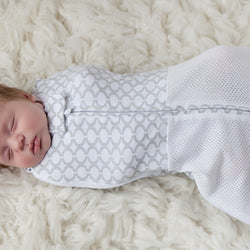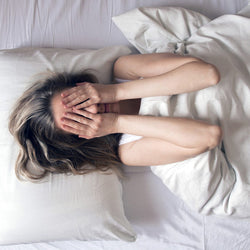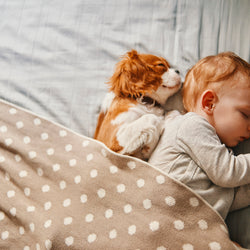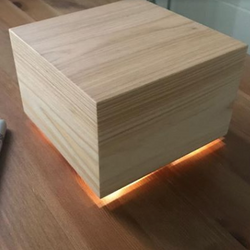Ultimate Guide to Safe Sleep Practices for Baby
All you need know for safe sleep for Baby
Where to sleep, what to wear, and how to position Baby for safe sleeping.

by Annie Wiesman
Apr 21, 2018
Sleep is a precious thing – our bodies and minds need it to function at our best. You would think that something so basic and necessary would be as simple as laying down and falling asleep, but we all know that is not the case.
Babies typically require training to reach optimal sleep. But before you even think of sleep training, you need to make sure that Baby’s environment is set up for safe sleeping.
According to the American Academy of Pediatrics (AAP), “approximately 3,500 infants die annually in the United States from sleep-related deaths, including sudden infant death syndrome (SIDS); ill-defined deaths; and accidental suffocation and strangulation.” SIDS is the leading cause of death in babies one month to one year old.
While these statistics can be alarming, I don’t intend to frighten you. We all know there are plenty of scary things out there of which we can be afraid. We just need to be aware of common risks so that we can make wise decisions and create the safest possible environment for baby.
Top Tips on Safe Sleep for Baby
Where to Sleep
• Numerous studies have shown that you can decrease the risk of SIDS if Baby sleeps in his or her own bed, in your bedroom, and for at least the first 6-12 months of Baby’s life. The AAP recommends against sharing a bed.
• The crib or bassinet mattress should be firm and fit snuggly with no spaces between the mattress and the crib frame. The sheet should be tightly fitted.
• Make sure the crib, bassinet, or pack-n-play portable crib is set up correctly and is not broken or adapted.
• There should be no bumpers, pillows, blankets or toys in the bed with the baby. Anything that could entrap, suffocate or strangle Baby needs to be removed from the crib. Older children may need a snuggly or favorite toy to sleep with, but infants should not have anything in the crib with them.
• Optimal temperature for sleep is 68-72 ℉. If it’s too cold, Baby could be uncomfortable and wake up. Overheating Baby may increase risk of SIDS.
What to Wear to Sleep
• Whether sleeping, playing or going outside, the general rule for dressing Baby is to wear what you are wearing plus one more layer.
• Sleep swaddles or sleep sacks are great as long as they don’t come loose.
• Wearable blankets are ideal for babies that can wiggle out of a swaddle, but still need an extra layer to keep them comfortable at night.
• While not exactly something to wear, the pacifier has been linked to lowering the risk of SIDS.
How to Position for Sleep
• Recommended sleep positions have literally flip-flopped over the years, but the current advice (according to the AAP) is to lay Baby flat on the back.
• Do not use sleep positioners or towels to keep Baby in place.
• If your baby is able to roll over and you are still swaddling with the arms tucked in, it’s time to keep the arms out so that she has more control.
Article Continues Below Advertisement
Sleep Safety Tips You May Not Have Thought of:
• To reduce the risks of SIDS, don’t smoke or let anyone else smoke around Baby.
• Breastfeeding has also been linked to reducing the risk of SIDS.
• According to the AAP keeping up with regular vaccinations may reduce the risk of SIDS by 50%.
• Reduce or eliminate Baby’s exposure to blue lights from media devices.
• Keep cords from monitors, curtains or blinds away from crib.
Taking time to establish a safe sleep environment will allow you and Baby to sleep peacefully and confidently through the night.
Annie Wiesman
Annie Wiesman is the co-author of “Education Begins at Birth: A Parent’s Guide to Preparing Infants, Toddlers, and Preschoolers for Kindergarten.” She is a former kindergarten teacher turned stay-at-home mom who enjoys traveling, hiking in the mountains, and creating memories together with her husband and little girl.












